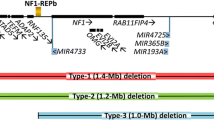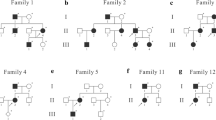ABSTRACT
Neurofibromatosis 2 (NF2) is an autosomal dominant disorder characterized by schwannomas and meningiomas that develop after inactivation of both copies of the NF2 gene. Approximately half of all patients with NF2 have unaffected parents and the disease results from new mutations at the NF2 locus. Loss of heterozygosity (LOH) in tumor specimens due to deletions covering the normal NF2 allele can be used to infer the haplotypes surrounding underlying mutations and determine the allelic origin of new mutations. We studied 71 sporadic NF2 patients using both LOH and pedigree analysis and compared the parental origin of the new mutation with the underlying molecular change. In the 45 informative individuals, 31 mutations (69%) were of paternal and 14 (31%) were of maternal origin ( P =0.016). Comparison with corresponding constitutional mutations revealed no correlation between parental origin and the type or location of the mutations. However, in 4 of 6 patients with somatic mosaicism the NF2 mutation was of maternal origin. A slight parent of origin effect on severity of disease was found. Further clinical and molecular studies are needed to determine the basis of these unexpected observations.
Similar content being viewed by others
Author information
Authors and Affiliations
Additional information
Received: December 21, 1999 / Accepted: February 28, 2000 / Published online: May 9, 2000
Rights and permissions
About this article
Cite this article
Kluwe, L., Mautner, V., Parry, D. et al. The parental origin of new mutations in neurofibromatosis 2. Neurogenetics 3, 17–24 (2000). https://doi.org/10.1007/s100480000088
Issue Date:
DOI: https://doi.org/10.1007/s100480000088




